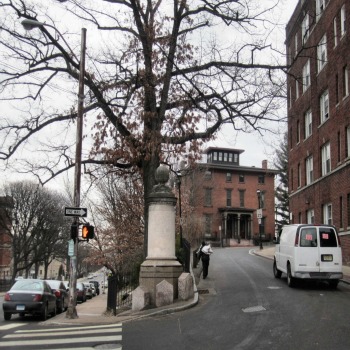
Though I'm not sure how many tourists make an effort to see the monument to the Charter Oak, unsurprisinglylocated at the intersection of Charter Oak Avenue and Charter Oak Place, I would bet that at least some do wander over to take a look. And I certainly felt that I should; a marker celebrating one of Connecticut's great creation stories seemed to fit perfectly in that category of important sites in one's own city which one ignores while traveling far greater distances to see less meaningful attractions.
The Charter Oak, best known for making people across the United States wonder why Connecticut put a tree on its state quarter, got its name from an incident in which it became the hiding place for the state's royal charter, given to the General Court of Connecticut by King Charles II in 1662. In 1687, when King James II wanted to revoke the charter – and with it, Connecticut's semi-autonomy, he sent Sir Edmund Andros to reclaim the document. But when it came time to hand it over, the candles dramatically went out. When they were lit again, the charter was gone. Legend has it Captain Joseph Wadsworth absconded with it, stashing it in a cavity of the white oak tree.
Once I got to the monument, I realized I had already been ignoring it for some time, and not even on purpose, as people do with the Empire State Building and similar unmistakable tourist magnets.
I was quite aware of the intersection, and the unusual way the roads diverge, the Avenue heading straight ahead while the Place climbs a gentle incline off to the right. In all the times I'd driven by, I had been so concerned with getting into the proper lane that I hadn't even noticed the modest monument standing on the corner.
And that is possibly the best thing about it. When the ancient oak was toppled in a storm in 1856, the Hartford Courant reported, "Our citizens flocked in crowds to the spot." The Colt's Armory Band played a "dirge" at noon, and "the bells all over the city were tolled at sundown as a token of the universal feeling, that one of the most sacred links that bind these modern days to the irrevocable past, had suddenly parted." For all the history in the tree itself, and all it symbolized to the people of Hartford centuries later, the design of the monument seems to say: Yes, this spot represents a momentous turning point in our past. But we are a historic city, and many great things have transpired here. We've seen it all, and if we went all crazy commemorating everything, it would be unseemly. It would be...uncool.
And we definitely wouldn't want that.